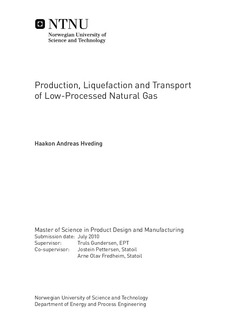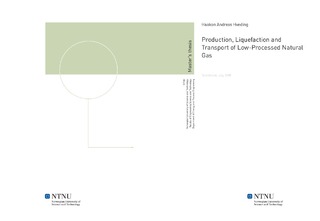| dc.description.abstract | The pre-processing and liquefaction of LNG is very energy demanding in addition to having a high level of complexity. This motivates for finding alternative value chains and technologies for gas transportation and various concepts have been proposed based on natural gas in liquid phase. These can be split into two main principles; liquefaction with solids formation, and storage under pressure. Due to the increased temperature and solubility, freezable components will not form solids as easily in the pressurized concepts allowing less pre-treatment of the gas. The evaluated concepts in this thesis are Liquefied Unprocessed Well Stream (LUWS) with controlled solids formation, and three pressurized storage concepts; Aker Solutions Heavy Liquid Gas (HLG), ExxonMobil s Pressurized Liquefied Natural Gas (PLNG) and Chevron s Liquefied Heavy Gas (LHG). All are presented in a high level survey together with similar ideas and patents in the first part of the thesis.Value chain evaluations are carried out for the different concepts and positive contributions, uncertainty and possible difficulties are discussed. The different patents filed, with solutions to some of the difficulties associated with the concepts, are also explained and presented. As the different gas products will have a less pure composition compared to LNG, the gas treating part of the value chains will be moved downstream of the liquefaction for all the new concepts. Through simplified simulations in PRO/II, energy requirements and specifications of the product liquid for the different concepts are found. The gas composition is adjusted to avoid freeze out of any kind for the pressurized liquids. The power needs for liquefaction are drastically decreased with increased pressure, giving smaller and less complex liquefaction plants. For a HLG concept at 20 bars, the power need is around halved, while for LHG at 50 bars it is between 25-39% compared to LNG, depending on the amount of heavy hydrocarbons in the LHG. The amount of flash gas needed for power production is as a direct result reduced by 70%.Water removal will still be necessary for all the concepts as hydrates will form easily at high pressures and low temperatures. The only exception is for the LUWS concept, where a smaller amount of water possibly could be allowed to form hydrates in a controlled way together with hydrocarbons and CO2.The reduced requirements for the gas means alternative processes for pre-treatment can be utilized and the thermal energy needs for these decreased at the liquefaction site. CO2 removal may be done by a membrane system or similar as the CO2 concentration can be around 1,4 and 6 mole% for a pressure of 12 and 50 bars respectively without the forming of solids. At the receiving site, a system similar to the CRYEX process can be implemented to remove the CO2 and allow storage of gas as LNG at atmospheric pressure.Estimations of the weight of the steel pressure vessels have been calculated for all the pressure levels. Due to the extremely high weight and the large amount of steel needed, the vessels must be constructed by an alternative building material for the high pressure ranges. A fiber reinforced plastic is suggested used with a steel or aluminum liner retaining the liquid. If successfully manufactured, these vessels would significantly reduce the weight and make HLG/LHG possible to implement. | nb_NO |

